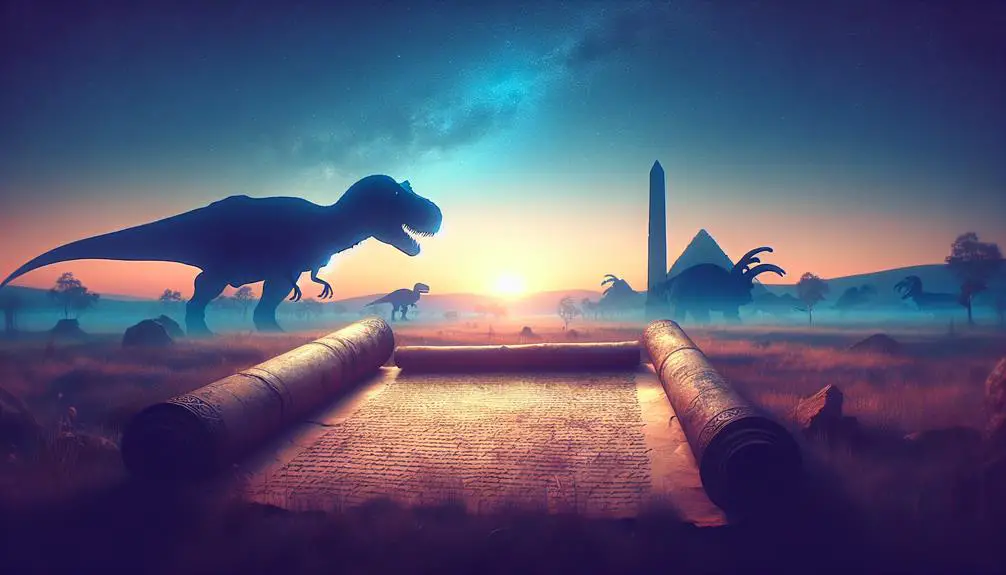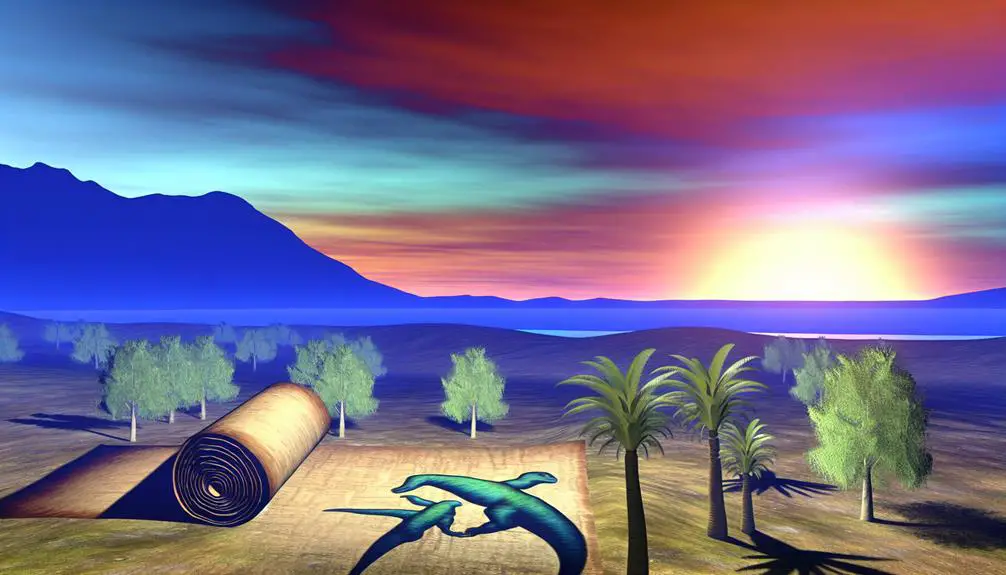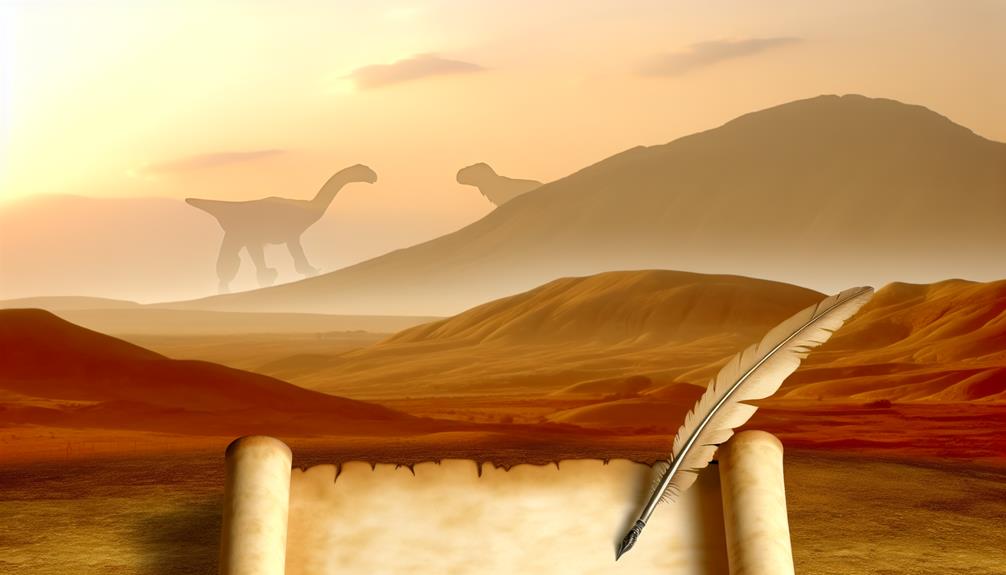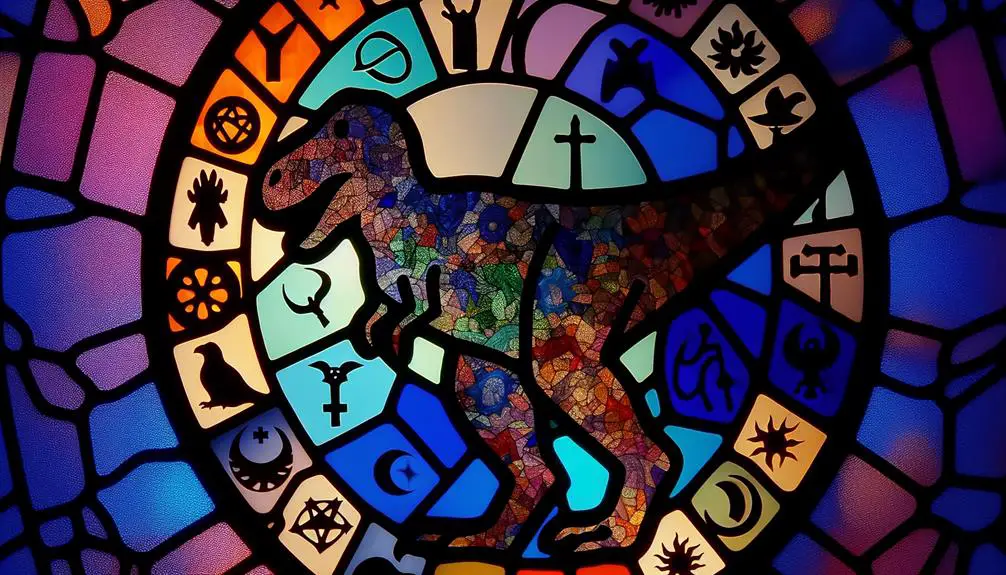See if the Bible's Leviathan and Behemoth hint at dinosaurs, sparking debates and curiosity among scholars and believers alike.

Are Dinosaurs in the Bible Verse
You might have missed the Sunday school lesson on the T-Rex in the Garden of Eden, but let's face it, the question of whether dinosaurs are mentioned in the Bible has tickled the curiosity of many.
The references to creatures like the Leviathan and Behemoth have sparked debates among scholars, theologians, and laypeople alike. Are these descriptions of mythical beasts, or could they be ancient accounts of dinosaurs?
By exploring the historical context of biblical writings and scientific insights on dinosaurs, you'll find compelling arguments that might challenge or reinforce your views. Let's embark on this journey together, shall we?
Key Takeaways
- Biblical texts describe large, mythical creatures like Leviathan, not dinosaurs as understood by modern science.
- Descriptions of creatures like Leviathan symbolize divine power rather than provide historical accounts of prehistoric life.
- Ancient interpretations of creatures akin to Leviathan are influenced more by mythology and symbolism than by paleontological evidence.
- Modern attempts to align biblical creatures with dinosaurs often reflect a misinterpretation of the text's symbolic and theological intentions.
Biblical Creatures and Interpretations

How do various translations and interpretations of the Bible approach the existence of creatures that could be likened to dinosaurs? It's a question that invites you to delve into the text's rich tapestry, where the lines between the material and the divine often blur.
Scholars have pointed out that while the Bible doesn't explicitly mention dinosaurs, its references to large and formidable beasts have sparked curiosity. These descriptions, however, are typically framed within contexts that emphasize angelic figures and divine interventions, rather than a scientific or historical account of Earth's biological history.
For instance, the depiction of behemoths and other colossal creatures in the scriptures is often intertwined with narratives that underscore the power and majesty of the divine. Rather than cataloging these entities as prehistoric animals, the text elevates them as symbols of God's creation and sovereignty. This approach suggests that the ancient authors were less concerned with the literal existence of these beings and more focused on their metaphorical significance within a spiritual and moral framework.
In analyzing these passages, it becomes clear that angelic figures and divine interventions serve as key interpretative lenses. They guide the reader's understanding of the text's monumental creatures, steering the conversation away from a literal historical presence and towards a theological reflection on the nature of power, creation, and the divine.
The Leviathan: A Prehistoric Beast?
You'll first examine the Leviathan's depiction in biblical texts, assessing its characteristics against known prehistoric creatures to discern potential links.
Next, you'll compare these ancient descriptions with our current understanding of dinosaurs, exploring the feasibility of such a connection.
Leviathan's Biblical Description
The biblical description of Leviathan paints it as a formidable sea creature, possibly reflecting ancient encounters with prehistoric marine beasts. This depiction not only stirs curiosity about its origins but also integrates deeply with ocean mythology and ancient symbolism, suggesting a blend of historical and mythical interpretations.
To understand Leviathan's significance, consider these key aspects:
- Vast size and strength, hinting at an unparalleled marine dominion.
- Fire-breathing capabilities, uncommon for known aquatic or semi-aquatic creatures, enriching its mythical status.
- Symbolism of chaos and evil, representing uncontrollable natural forces and moral challenges.
- Role in ancient narratives, serving as a benchmark for God's power and the natural order.
Analyzing Leviathan within this context offers insights into how ancient cultures perceived and mythologized the natural world.
Comparing Leviathan to Dinosaurs
Many scholars have ventured to compare Leviathan, as described in biblical texts, to known prehistoric dinosaurs, suggesting a possible link between scriptural narratives and paleontological evidence. This comparison dives deep into marine mysteries and uncovers fossilized facts that could potentially bridge the gap between ancient texts and the scientific understanding of prehistoric life.
Feature |
Leviathan in Texts |
Prehistoric Dinosaurs |
|---|---|---|
Habitat |
Marine |
Mostly terrestrial, some marine |
Size |
Immense |
Ranged from small to gigantic |
Physical Description |
Scales, fearsome teeth |
Varied, some had scales and sharp teeth |
Mystique |
Symbol of chaos |
Subjects of fascination, research |
The analysis of these aspects reveals a complex picture, where some characteristics of Leviathan align with those of known dinosaurs, particularly marine reptiles, emphasizing the intrigue in these ancient creatures.
Modern Interpretations of Leviathan
In recent times, scholars have increasingly viewed Leviathan through the lens of paleontological insights, suggesting its depiction might stem from humanity's encounters with prehistoric marine reptiles. This perspective intertwines with maritime mythology, painting Leviathan not just as a biblical monster but as a possible echo of the creatures that once navigated ancient seas. Such interpretations hinge on a blend of scripture, fossil records, and accounts of ancient navigation, offering a compelling narrative that bridges theological texts and natural history.
- Maritime mythology enriches our understanding of Leviathan's origins.
- Ancient navigation tales might hold clues to its real-life counterparts.
- Paleontological insights provide a scientific basis for Leviathan's depiction.
- Scriptural and natural history converge, offering a unified narrative of this mythical creature's roots.
Behemoth: The Earth's First Giant?
Throughout history, scholars have debated whether Behemoth, as described in ancient texts, represents Earth's first recorded giant. This creature, often shrouded in mystery and awe, sits at the intersection of giant mythologies and paleontological inaccuracies, challenging our understanding of the natural world and its ancient inhabitants. As you delve deeper into the scholarly interpretations, it becomes apparent that the descriptions of Behemoth may not align perfectly with our current paleontological records. This discrepancy raises questions about the nature of Behemoth and whether it was a product of the ancients' imagination or a misunderstood real entity.
The debate around Behemoth also touches on the broader subject of how ancient cultures interpreted their surroundings and the remnants of the prehistoric past. Giant mythologies, found in various cultures, often reflect an attempt to make sense of the bones and fossils encountered, which, without the benefit of modern science, were ascribed to mythical creatures. These narratives, while rich in cultural significance, introduce paleontological inaccuracies when viewed through the lens of contemporary science. As such, understanding Behemoth requires not only a look into ancient texts but also a critical analysis of how historical interpretations have shaped our view of the natural world.
Historical Context of Biblical Writings

To understand biblical references accurately, you must consider the historical context of its writings. Analyzing the era of composition sheds light on how cultural influences may have shaped the text's content and interpretations.
This approach will allow you to grasp the potential nuances and meanings behind mentions of creatures like dinosaurs in the scriptures.
Composition Era Analysis
Understanding the historical context of biblical writings requires analyzing the era in which these texts were composed. This period didn't have access to modern scientific methods, such as radiometric dating, which have led to significant fossil discoveries and a deeper understanding of Earth's history. To grasp the mindset and knowledge base of biblical authors:
- Consider the absence of radiometric dating techniques in their era.
- Acknowledge the lack of fossil discoveries that inform current paleontological knowledge.
- Realize the biblical texts were written from a pre-scientific perspective.
- Understand that interpretations of these texts need to account for the historical and scientific knowledge of the time.
This approach allows for a more accurate evaluation of how dinosaurs and other prehistoric entities are or aren't represented within biblical literature.
Cultural Influences Explored
Shifting focus to the cultural influences, it's crucial to examine the historical context in which biblical texts emerged, considering how societal norms and belief systems of the time shaped the authors' perspectives and writings. The era's fossil controversies and artistic representations offer a glimpse into how ancient peoples interpreted their world.
Era |
Influence on Biblical Texts |
Key Examples |
|---|---|---|
Ancient Near East |
Mythological elements |
Artistic representations |
Roman Period |
Political context |
Fossil controversies |
Medieval Era |
Allegorical interpretations |
Artistic representations |
Renaissance |
Humanistic perspectives |
Fossil controversies |
Modern Era |
Scientific understanding |
Artistic representations |
This analysis underscores the importance of contextualizing biblical narratives within their historical era to understand the interplay between cultural influences and the texts' development.
Scientific Insights on Dinosaurs
Despite centuries of speculation, recent scientific advancements have provided us with a clearer understanding of dinosaurs' biology, behavior, and extinction. You're now entering a realm where the mysteries of the past slowly unravel, revealing facts once hidden within the depths of the Earth.
- Dinosaur extinction theories have evolved, pointing towards catastrophic events like asteroid impacts and volcanic activity, rather than simplistic, outdated notions.
- Fossil record gaps, once a major hurdle in understanding dinosaur evolution, are gradually being filled, offering a more complete timeline of their existence.
- Advanced imaging and analysis techniques allow scientists to study the soft tissues of dinosaurs, providing insights into their growth, reproduction, and daily activities.
- Cutting-edge genetic research hints at the connections between dinosaurs and modern birds, shedding light on the evolutionary trajectory.
These scientific insights offer a window into the lives of these magnificent creatures, far beyond the bones they left behind. By piecing together the puzzle of their existence, you gain not just knowledge of their demise but an appreciation for the dynamic history of life on Earth. This approach, grounded in evidence and analysis, steers clear of the debates surrounding dinosaurs and creationism, focusing instead on tangible, verifiable facts.
Dinosaurs and Creationism Debates

Dinosaurs in the Bible
Dinosaurs and Creationism Debates
Many debates surrounding dinosaurs and creationism stem from differing interpretations of ancient texts and scientific findings. You'll find that the heart of these discussions often revolves around fossil controversies and the evolutionary timeline.
Here's a concise comparison highlighting key points of contention:
Aspect |
Creationism View |
Scientific Community View |
|---|---|---|
Earth's Age |
Young (6,000 – 10,000 years) |
Old (4.5 billion years) |
Fossil Formation |
Result of a global flood |
Gradual, over millions of years |
Dinosaurs' Existence |
Coexisted with humans |
Existed millions of years before humans |
Interpretation of Fossils |
Supports the Biblical narrative |
Evidence of evolution |
Evolutionary Timeline |
Disputed or rejected |
Supported with extensive evidence |
This table underscores the divergent perspectives that fuel the ongoing dialogue between creationism proponents and the scientific community. Each side interprets evidence through its lens, leading to fundamentally different conclusions about the history of life on Earth.
Mythical Beasts or Ancient Dinosaurs?
The question of whether ancient texts depict dinosaurs or mythical beasts has long intrigued scholars and laypeople alike. As you delve into this topic, it's essential to differentiate between interpretations based on dragon symbolism and those grounded in fossil records. This distinction is crucial for an accurate understanding of historical descriptions.
- Dragon Symbolism: Often embodies chaos, strength, and sometimes wisdom across various cultures, potentially inspired by fossilized remains of dinosaurs.
- Fossil Records: Provide concrete evidence of dinosaurs' existence long before humans, challenging the notion that ancients could have encountered these creatures alive.
- Linguistic Analysis: Examines how translations and the evolution of language influence our understanding of ancient texts, including the Bible.
- Archaeological Context: Helps determine whether descriptions of creatures in ancient texts align more closely with known animals, mythological beasts, or dinosaurs.
Analyzing these aspects reveals that while the allure of linking dinosaurs directly to the dragons and behemoths of ancient texts is strong, the evidence leans more towards symbolic interpretations rather than factual accounts of human-dinosaur coexistence. It's a reflection of humanity's attempt to make sense of the natural world, albeit through the lens of myth and metaphor rather than paleontological fact.
Cultural Impact of Dinosaurs in Religion

Exploring the cultural impact of dinosaurs in religion requires us to consider how these ancient creatures have been woven into the fabric of spiritual beliefs and practices over time. The discovery and interpretation of dinosaur fossils have often intersected with religious views, leading to various interpretations that blend scientific inquiry with spiritual significance. You'll find that religious symbolism has been enriched by the incorporation of these prehistoric beings, illustrating a fascinating intersection of faith and paleontology.
Fossil interpretations have played a pivotal role in this nexus, as different religious communities have sought to understand these ancient remains within the context of their spiritual narratives. For some, dinosaurs are seen as evidence of a world before the one described in sacred texts, challenging traditional timelines and prompting a reevaluation of scriptural interpretations. For others, these creatures are integrated into religious stories, serving as symbols of power, creation, and the vastness of divine influence.
The impact of dinosaurs on religion is profound, offering a unique lens through which to explore the relationship between faith and the natural world. This interplay between religious symbolism and dinosaur discoveries underscores the dynamic ways in which spiritual beliefs adapt and evolve in response to scientific advancements.
Frequently Asked Questions
How Do Modern Translations of the Bible Differ in Their Description of Creatures That Could Be Interpreted as Dinosaurs?
You'll find that modern translations of the Bible vary significantly in describing creatures that might be interpreted as dinosaurs, due to differences in translation methodologies and cultural influences.
Scholars often debate the precision and intent behind these texts, as translation methods range from literal to more interpretative, influenced by contemporary understanding and cultural contexts.
This variation leads to distinct portrayals of these creatures, reflecting the complex interplay between historical texts and modern interpretation.
Are There Any Dinosaur Species Discovered by Paleontologists That Closely Match the Descriptions of Creatures in the Bible?
You might find it fascinating that while paleontologists have unearthed a variety of dinosaur species, none directly match biblical descriptions. The creatures mentioned, like ancient behemoths, often seem more mythological than factual, lacking clear parallels to known dinosaurs.
Instead, these descriptions likely stem from attempts to explain unearthed bones or fossils with limited scientific understanding, blending myth with reality but not accurately reflecting our current knowledge of dinosaurs.
How Do Children's Interpretations of Dinosaurs in the Bible Differ From Those of Adults or Scholars?
You'll find that children's interpretations of dinosaurs in the Bible are often fueled by their vivid childhood imagination, painting these ancient creatures with a sense of wonder and adventure.
In contrast, adults and scholars engage in scholarly debates, focusing on textual analysis and historical context to understand these references.
This difference in perspective highlights the gap between imaginative interpretation and scholarly inquiry, showcasing the diverse ways people engage with biblical texts.
What Role Do Dinosaurs Play in Other Religious Texts Outside of the Bible?
You might think dinosaurs are purely a scientific discussion, but they also find their place in other religious texts. In Hindu mythology, comparisons can be drawn between descriptions of certain creatures and what we know of dinosaurs.
Similarly, Islamic scripture references ancient beasts that could parallel the dinosaurs' descriptions. This analytical exploration shows that the intrigue surrounding these ancient creatures transcends cultures and beliefs, inviting a scholarly and objective look beyond the scientific realm.
How Have Depictions of Biblical Creatures That Resemble Dinosaurs Evolved in Religious Art and Media Over the Centuries?
In exploring how depictions of biblical creatures resembling dinosaurs have evolved, you'll find that medieval bestiaries and cultural symbolism play pivotal roles.
Initially, these depictions were more imaginative, rooted in myth and the limited scientific understanding of the times.
Over the centuries, as paleontology advanced, interpretations became more realistic, reflecting a blend of religious beliefs and scientific discoveries.
This evolution mirrors broader changes in how societies understand and integrate the concept of ancient creatures within religious contexts.
Conclusion
In conclusion, while the Bible doesn't explicitly mention dinosaurs as we understand them today, creatures like the Leviathan and Behemoth invite intriguing interpretations. Some argue these descriptions fit prehistoric beings, suggesting a historical overlap. However, it's essential to consider the metaphorical nature and cultural context of biblical texts.
Despite debates, integrating scientific insights with religious narratives enriches our understanding of both realms. This synthesis doesn't diminish faith or science but rather highlights the complex relationship between religion, history, and the natural world.



Sign up